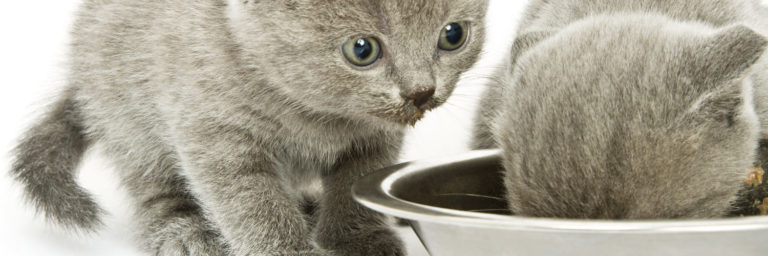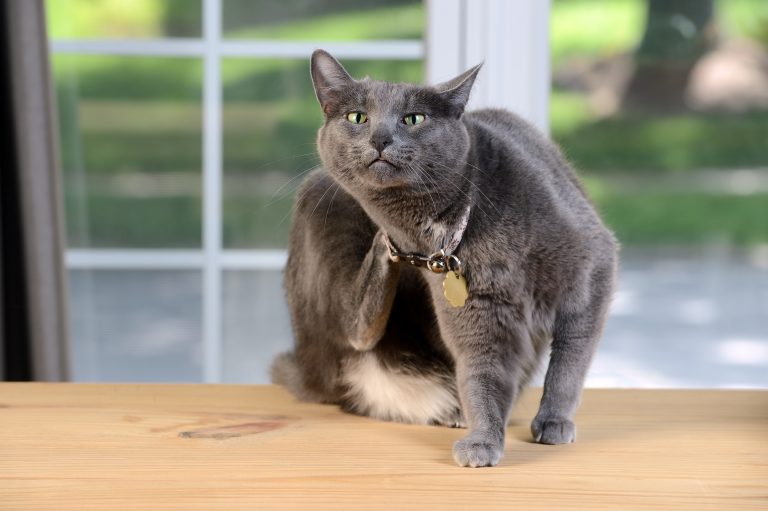Best Flea Treatment for Cats
Contents of Article
What has the ability to jump more than one hundred times the length of its body and poses a serious threat to your cat’s health? The common cat flea.
Fleas are tiny insect parasites that have the ability to jumpf up to seven inches high, clearing a horizontal distance of 8 inches or more. Small as they may be, fleas can irritate your cat’s skin to the point that he develops hot spots, bald patches, and even oozing lesions. In short, a flea infestation is not something you want to ignore.
Fleas are very common and all it takes is a few of them to create a big problem. Fortunately, flea prevention is very easy with myriad flea control products on the market.
With so many options, however, it can be difficult to make a choice. In this article, you’ll receive valuable information about the dangers of fleas for cats as well as tips for identifying and dealing with a flea infestation. You’ll also receive an overview of the top five types of flea control and our top ten picks for the best flea treatments for cats.
What Are the Dangers of Fleas for Cats?
The cat flea (Ctenocephalides felis felis) is the most common external parasite known to affect cats and, though they may be small, they have great potential for becoming a serious nuisance for both you and your cat. Though the average flea may not seem like much of a threat at up to 3.3 mm in length, these parasites can mean big trouble when they start to multiply. Your cat’s coat is the ideal environment for these tiny pests, providing shelter as well as food and a place to reproduce. All it takes is a couple of fleas to produce an infestation and it can happen in the blink of an eye.
As a type of parasite, fleas feed on the blood of their hosts – female fleas also use the blood to create the “blood meal” that is required to lay her eggs. Flea bites can cause itching which leads your cat to scratch the affected area. With serious flea infestations, myriad flea bites can cause horrible itching to the degree that your cat actually hurts himself with scratching. Incessant scratching can open up wounds in the skin which then become vulnerable to infection. Some cats also develop an allergic reaction to flea saliva, some of which is transferred to your cat’s skin with every bite – this is called flea allergy dermatitis. Left untreated, a serious flea infestation may also cause anemia related to blood loss.
Though most of the problems caused by fleas are external and skin-related, there is the potential for internal infection as well. Fleas are known to carry tapeworms which can be passed on to your cat if he ingests an infected flea, generally through grooming. Tapeworms are segmented parasites that look like maggots and which range in size from ½ inch to 12 inches. If your cat has a tapeworm infection, you may notice him licking or biting his anus or dragging his hindquarters across the floor to soothe irritation. You may also notice tiny seed-like segments in his feces. Fortunately, tapeworms can be treated fairly easily.
How To Tell If Your Cat Has Fleas
Flea bites don’t always cause an allergic reaction and some cats don’t even become itchy. There are some other signs you can look for, however, to see if your cat has fleas. Here are some of the top signs that your cat has a flea infestation:
- Your cat is scratching or biting at his skin and coat more often than usual.
- Your cat is grooming himself more frequently, particularly focusing on the hind legs and the base of the tail.
- Your cat may scratch or groom himself so much that he develops bald patches.
- Your cat might start to avoid certain rooms in the house that have carpeting and upholstered furniture (these areas tend to harbor more fleas).
- Your cat may suddenly become agitated or restless – you may see him shaking his head, rubbing on objects, or darting from one room to another.
- Your cat might develop itchy red lesions on the skin which may start to ooze.
- Your cat may develop signs of anemia such as weight loss, pale gums, and lethargic behavior.
- You see tiny black specks on your cat’s fur or red spots on his bedding.
If you suspect that your cat may have fleas, there are a few different things you can do to confirm your suspicions. One thing you can do is take a close look at the skin near the base of your cat’s tail as well as the skin on his belly and groin – part the hair and look for fleas or signs of fleas. Remember, fleas are very small (usually 1/16 to 1/8 inch long) but you can see them if you look close enough. You may also see flea dirt, flea feces that looks like tiny pepper-like specks. You can use a flea comb to collect some of these specks and place them on a paper towel then mist them with water to see if they turn red. Flea dirt is composed of digested blood, so it turns red when wet.
Best Flea Comb For Cats
Before you can treat fleas, you need to make sure they’re there. Sure you can use a regular old fine-tooth comb intended for human hair, but you’ll probably want to throw that thing away afterward. With our pick for the top flea comb you’ll get a reusable, no nonsense tool that easily parts your cats fur near the skin to get an unobstructed view of the offending pests.
Sentry Flea Comb For Cats Review
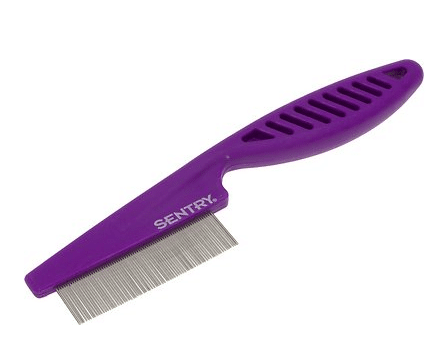
At nearly the price of a coffee Sentry’s flea comb has fine wire bristles that easily pick through your cats fur.
Not only does it allow you close inspection of your cat’s skin where you’re most likely to see any fleas, but it also let’s you rake through their hair to pull out any of the parasites for further examination on an object that’s not moving (aka a white piece of paper). Your cat will appreciate you leaving it alone while you continue to freak out. – Buy It
How To Check Your Home For Fleas
In addition to checking your cat for fleas, you can also check your home. Take a close look at your cat’s bedding as well as the places where he tends to spend a lot of time such as his feeding area. Check your carpeting and upholstered furniture for fleas and flea dirt as well, since these are the areas most likely to harbor fleas. Another way to check for fleas is to put on a pair of white socks and then walk around the areas where your cat spends a lot of time – if you find tiny black specks or red spots on the bottom of your socks, it could be a sign of fleas. Fleas are also drawn to light, so setting up a light next to a bowl of water at night can serve as a flea trap to confirm your suspicions of flea infestation.
What Are the Options for Flea Control?
When it comes to flea control, there a few key things to look for. First, you want to find a product that will kill adult fleas on your cat’s body. Second, you want a flea control product that will either kill flea eggs and larvae or prevent them from growing into biting adult fleas. Third, you want something that will protect your cat against future infestations. Flea control products come in a variety of different forms – here is a quick overview of the most popular options:
- Flea Collars – A flea collar utilizes concentrated chemicals that become dispersed over your cat’s body to kill adult fleas and to prevent eggs and larvae from developing. Flea collars can last for several months and they often provide protection against ticks as well. Though flea collars are convenient and easy to use, some of them have a strong odor that can irritate your cat.
- Flea Spray – One of the most inexpensive methods of flea control, flea sprays can be used to kill fleas that are already on your pet and some products provide long-term protection as well. Most flea sprays need to be massaged into the cat’s skin and coat for maximum efficacy and they may be washed off easily, so your cat will need to stay dry.
- Topical Treatments – Topical flea medications are typically applied to the cat’s skin at the base of the neck or between the shoulder blades. Many topical treatments are effective against ticks and mosquitos as well as fleas and they generally provide a full month of protection. This type of treatment works because the active ingredients become deposited into the cat’s seat glands so it can be distributed over the entire body over time.
- Flea Pills – Oral flea medications can provide up to 30 days of protection and there are some products that also protect against ticks, heartworm, and other internal parasites. These medications have a low risk for side effects such as vomiting or diarrhea, though some cats develop an allergic skin reaction, become depressed, or lose their appetite.
- Flea Shampoo – A short-term flea control product, flea shampoos help to kill adult fleas on contact and wash them away along with eggs and larvae. Flea shampoos typically need to be left on the skin for 10 to 15 minutes before rinsing for maximum efficacy and they are usually safe to use every day until the infestation is under control.
The type of flea control product you choose for your cat depends on several factors. For example, if your cat is already infested with fleas you might want to use a flea shampoo or flea spray to kill the existing fleas before switching to a long-term control product. If you are just looking to protect your cat against flea infestations, however, a flea collar, spray, or pill might be the better option. Keep reading to learn more about our top choices for flea control products in the five categories listed above.
The Top 10 Flea Control Products for Cats
Though there are many different flea control products on the market, not all of them are deemed both safe and effective for cats. Even some of the treatments that are considered safe don’t work as well as other products, nor do they have positive user reviews. We’ve done the research to come up with our list of the top ten flea control products for cats – here are our picks:
The Best Flea Collar for Cats
| Collar | Price | Effectiveness | Rating |
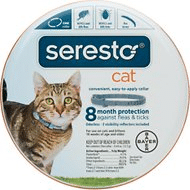 Seresto Flea & Tick Collar Seresto Flea & Tick CollarRead Reviews |
$$$$ |  |
 |
Seresto Flea & Tick Collar from Bayer Review

This flea collar is the undisputed champion when it comes to a comparison of flea collars for pets. The Seresto flea and tick collar offers a full eight months of protection against both fleas and ticks in all life stages. This collar features innovative Sustained Release Technology in a non-greasy formula that is easy to use – simply put it on your cat, adjust the fit, and you are good to go. The Seresto collar utilizes two active ingredients, imidacloprid and flumethrin, which are released in low concentrations over your cat’s skin and coat for continuous protection. Best of all, the active ingredients kill pests on contact before they even have a chance to bite.
Pros for Seresto Flea Treatment
- Offers a full 8 months of protection
- Effective against fleas and ticks in all life stages
- Lightweight and easy to wear
- Has a breakaway safety feature for cats
- Non-greasy, odor-free formula
- Features two active ingredients for continuous protection
Cons for Seresto Treatment
- Not recommended for cats under 10 weeks of age
- Some cats experience diarrhea within the first few days of wear
- Costs upwards of $50 (but for 8 months of protection)
The Best Flea Spray for Cats
| Spray | Price | Effectiveness | Rating |
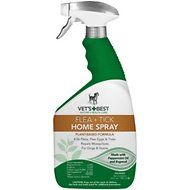 Vet’s Best Natural Flea & Tick Spray Vet’s Best Natural Flea & Tick SprayRead Reviews |
$ |  |
 |
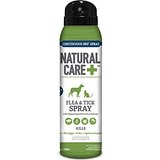 Natural Care Flea & Tick Spray Natural Care Flea & Tick SprayRead Reviews |
$ |  |
 |
Vet’s Best Natural Flea & Tick Spray Review

This flea and tick spray is made from plant-based ingredients including certified natural essential oils to provide powerful, non-toxic protection against fleas and ticks. Though this formula may have a strong scent at first, it is safe for kittens 12 weeks and older, plus it can be used on your cat’s bedding as well as other household surfaces. For maximum efficacy, spray this formula all over your cat then massage it into his skin and coat. It is a non-staining formula, so you don’t have to worry about your cat tracking it around. Vet’s Best makes a number of different formulas for flea spray, including one that can be used to kill fleas and ticks in the home.
Pros for Vet’s Best Flea Treatment
- Made with all natural plant-based ingredients
- Safe for use in cats and kittens over 12 weeks of age
- Protects against both fleas and ticks
- No added fragrances or toxic chemicals
- Safe for use around children and can be used on household surfaces
Cons for Vet’s Best Flea Treatment
- Not recommended for kittens under 12 weeks of age
- Has a strong odor that some cats may not like
Natural Care Flea & Tick Spray Review

This natural flea control spray is effective against adult fleas and their eggs as well as ticks, killing on contact. Natural Care flea and tick spray is safe for kittens 12 weeks and older, plus it is safe for use around children and can be used on indoor and outdoor surfaces. Made in the USA using all natural plant extracts like clove extract and peppermint oil, this flea and tick spray should be sprayed directly onto your cat and worked into his skin and coat for maximum efficacy.
Pros for Natural Care Flea Treatment
- Made from all natural plant extracts like clove and peppermint
- No toxic chemicals or added fragrances
- Effective against fleas, ticks, and mosquitoes as well as eggs
- Safe for kittens 12 weeks and older and for use around children
- Can also be used on household surface and cat bedding
Cons for Natural Care Flea Treatment
- Not recommended for kittens under 12 weeks of age
- Has a strong odor that some cats may not like
The Best Topical Flea Treatment for Cats
| Topical Formula | Price | Effectiveness | Rating |
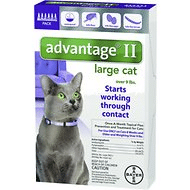 Advantage II Spot Flea Treatment Advantage II Spot Flea TreatmentRead Reviews |
$$$ |  |
 |
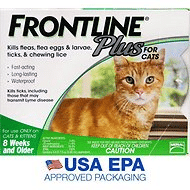 Frontline Plus Flea & Tick Treatment for Cats & Kittens Frontline Plus Flea & Tick Treatment for Cats & KittensRead Reviews |
$$$$ |  |
 |
Advantage II Review

This topical treatment provides a full thirty days of protection against fleas and ticks in all life stages. This product kills insect pests on contact – they don’t even have to bite your cat – and is also effective against eggs and larvae. Simply apply the treatment to the base of your cat’s neck and it will be distributed over his coat through the sweat glands, providing continuous protection that won’t wash away with normal bathing and grooming. Advantage II kills adult fleas with 5 to 10 minutes of application and kills 99% of larvae within 20 minutes – all fleas will be dead within 12 hours.
Pros for Advantage II Flea Treatment
- Provides a full 30 days of protection against fleas and ticks in all life stages
- Kills on contact, fleas don’t have to bite for it to work
- Safe for use on kittens 8 weeks and older
- Comes in different formulas for cats of different sizes
- Kills adult fleas within 10 minutes and larvae within 20 minutes
Cons for Advantage II Flea Treatment
- Not recommended for kittens under 8 weeks of age
- Larger cats may need a higher dose
Frontline Plus for Cats Review

This spot-on treatment is fast-acting, long-lasting, and waterproof. It provides a full month of protection for kittens and cats over 8 weeks of age against fleas and ticks in all life stages. This treatment utilizes powerful active ingredients and an insect growth regulator to kill adult fleas as well as eggs and larvae – it is also effective against chewing lice. Frontline Plus starts killing fleas within 24 hours of application and it lasts for a full month with regular grooming and bathing. This formula is easy to apply and it won’t wash off, plus it comes with a satisfaction guarantee. If you’re looking for a long-term treatment that you can apply just once a month, Frontline Plus is a great option.
Pros for Frontline Plus Flea Treatment
- Provides 30 days of protection against fleas and ticks in all life stages
- Starts killing fleas within 24 hours of application
- Safe for use on kittens 8 weeks and older
- Comes in different formulas for cats of different sizes
- Also effective against eggs, larvae, and chewing lice
Cons for Frontline Plus Flea Treatment
- Not recommended for kittens under 8 weeks of age
- Larger cats may need a higher dose
The Best Prescription Flea Pill for Cats
| Presciption Tablet | Price | Effectiveness | Rating |
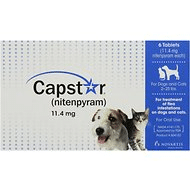 Capstar Flea Control Tablets (RX required) Capstar Flea Control Tablets (RX required)Read Reviews |
$ |  |
 |
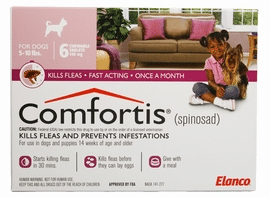 Comfortis Flea Pill Comfortis Flea PillRead Reviews |
$ |  |
 |
Novartis Capstar Flea Control Tablets Review

Available without a prescription, Capstar tablets are one of the most popular oral flea medications on the market. This flea pill utilizes nitenpyram, a powerful neurotoxin that starts killing fleas fast and wipes them out within 6 hours. Capstar only provides 24 hours of protection, but it is a great option if you’re looking for something to jumpstart your flea removal process. This treatment is only recommended for kittens over 4 weeks of age and for cats that weigh more than 2 pounds. It also comes with a risk for side effects like vomiting and diarrhea, though users report fewer side effects than for other oral medications.
Pros for Capstar Flea Treatment
- Starts killing fleas fast, kills all fleas within 6 hours of treatment
- Provides 24 hours of protection and can be administered daily
- Available without a prescription, less expensive as well
- Active ingredient nitenpyram is a powerful neurotoxin for fleas
Cons for Capstar Flea Treatment
- Only provides 24 hours of protection
- Not recommended for kittens under 4 weeks or less than 2 pounds
- Comes with a risk for side effects like vomiting and diarrhea
- Doesn’t kill flea larvae or eggs
Comfortis Flea Pill Review

This flea pill is available by prescription only and it is an FDA-approved chewable tablet that provides a full month of protection against fleas. This treatment is convenient and easy to use, plus it starts killing fleas in just 30 minutes, before they have a chance to lay eggs. Comfortis kills 98% of fleas in just four hours and it keeps protecting for 30 days. This treatment is only recommended for kittens and cats 14 weeks older and over 2 pounds, but it is highly effective and there is no risk of it washing off or putting your family at risk with chemical ingredients. Comfortis does come with the risk for side effects like vomiting and diarrhea, though not all cats develop side effects.
Pros for Comfortis Flea Treatment
- Provides a full month of protection against fleas
- Starts killing fleas in 30 minutes before they can lay eggs
- Safe for use around children and other household pets
- Easy to administer and only needs to be given once a month
- Kills 98% of fleas within four hours on cats
Cons for Comfortis Flea Treatment
- Not recommended for cats and kittens under 12 weeks of age
- Only available by prescription
- May not be effective in cats that weigh less than 2 pounds
- Doesn’t kill flea larvae or eggs
- Comes with a risk for side effects such as vomiting and diarrhea
The Best Flea Shampoo for Cats
| Shampoo | Price | Effectiveness | Rating |
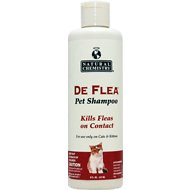 Natural Chemistry De Flea Shampoo Natural Chemistry De Flea ShampooRead Reviews |
$ |  |
 |
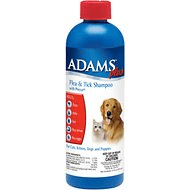 Adams Plus Flea & Tick Shampoo Adams Plus Flea & Tick ShampooRead Reviews |
$ |  |
 |
Natural Chemistry De Flea Shampoo Review

This flea shampoo is made with safe, natural ingredients – it doesn’t contain any harsh chemicals or insecticides like pyrethrins or permethrins. Natural Chemistry De Flea Shampoo is a botanical formula that kills fleas on contact for up to 7 days and it is also effective against black flies and mosquitos. This all natural formula is effective in killing fleas in all life stages without the use of an insect growth regulator – it features natural ingredients like cinnamon oil, cedar oil, and clove oil. Natural Chemistry flea shampoo is only recommended for kittens over 8 weeks of age and it does have a strong odor that some cats may not like. As a bonus, however, it contains soothing natural ingredients to moisturize your cat’s skin and coat.
Pros for Natural Chemistry Flea Treatment
- Made with safe and natural ingredients (no pyrethrins or permethrins)
- Contains soothing natural ingredients to moisturize skin and coat
- Effective against fleas and ticks in all life stages for up to 1 week
- Can be safely used with other flea control products for cats
Cons for Natural Chemistry Flea Treatment
- Not recommended for kittens under 8 weeks of age
- Doesn’t provide long-term protection against fleas over 1 week
- Might have a strong odor at first
Adams Plus Flea & Tick Shampoo with Precor Review

Made with powerful active ingredients and an insect growth regulator, Adams Plus flea and tick shampoo is one of the most effective and long-lasting flea shampoos on the market. This product offers a full 28 days of protection against fleas and ticks in all life stages including eggs and larvae. It starts working on contact and provides long-lasting control that many flea shampoos simply can’t offer. You’ll also be glad to know that it contains soothing natural ingredients like aloe, coconut extract, lanolin and oatmeal which help to remove dandruff and scales while moisturizing skin and coat. This product is only recommended for kittens over 8 weeks of age but it will wipe out 95% of the active flea population on your cat.
Pros for Adams Flea Treatment
- Effective against fleas, ticks, and lice as well as flea eggs and larvae
- Contains soothing ingredients like aloe, coconut extract, lanolin and oatmeal
- Provides a full 28 days of protection against fleas in all life stages
- Contains an insect growth regulator for long-lasting control against fleas
- Helps to remove dandruff and scales while moisturizing skin and coat
Cons for Adams Flea Treatment
- Contains chemicals and insect growth regulators
- Not recommended for kittens under 8 weeks of age
- Only knocks out 95% of the active flea population
In addition to using the products above to get your cat’s flea infestation under control, you also want to do a thorough cleaning of your house to prevent re-infestation. Start by sweeping your tile and hardwood floors and vacuum your carpet, upholstery, and pet bedding. When cleaning your home, be sure to use a flea control carpet spray and don’t forget to spray under furniture and in between cushions. If your flea infestation is very serious, you might consider hiring a professional to fog your home. Don’t forget about your yard, either – killing fleas outside will help to prevent them from coming into your home on your pet or on your own body.
As you do a deep cleaning of your home, be sure to throw away the bag every time you vacuum – the flea eggs and larvae you vacuum up can still mature into biting adults. When cleaning hard flooring, don’t forget about the baseboards and don’t neglect the dark areas under furniture. Wash your cat’s bedding as well as his toys using hot water to kill both adult fleas and their eggs. Keep cleaning your home regularly until you no longer see any fleas, keeping in mind that it could take a few weeks to completely eradicate an infestation.
Are There Any Natural Flea Control Methods?
If you prefer not to expose your cat to chemicals, you’ll be glad to know that there are some natural alternatives to commercial flea control products. Grooming your cat daily with a flea comb is a great way to naturally prevent flea infestations and bathing him occasionally in mild dishwashing detergent may help as well. Here are some other natural flea control methods to consider:
- Apple Cider Vinegar – Add a spoonful of apple cider vinegar to your cat’s water bowl to make his skin more acidic and less attractive to fleas. If your cat doesn’t like the taste, dilute it in a 50/50 solution with water then spritz it lightly over his coat.
- Rosemary Flea Dip – Boil two cups of fresh rosemary in water for thirty minutes then strain the liquid and mix it into a gallon of warm water. Let the water cool to lukewarm then pour it over your cat until his fur is saturated then remove the excess moisture and allow him to air dry.
- Lemon Flea Repellant Spray – To make your own flea repellent spray, slice a lemon and cover it with water then bring the water to a boil. Turn off the heat and let the mixture steep overnight. Pour the liquid into a bottle and spray it over your cat and work it into his coat.
- Lavender Essential Oil – Give your cat a bath with warm water and a mild dishwashing detergent. After toweling him dry, apply a drop or two of lavender essential oil to the base of his tail and at the base of his neck.
- Diatomaceous Earth – Vacuum your carpet, rubs, and upholstery well then dust the area with diatomaceous earth, making sure to keep the area dry. Leave the application in place as long as possible, at least two to three weeks.
Another important aspect of natural flea control is keeping fleas out of your yard so they don’t have a chance to enter your house. One way to protect your yard is to use nematodes for two to three weeks at the beginning of each spring. Nematodes are tiny wormlike creatures that help to control a variety of insect pests including fleas, ants, grubs, and termites. You can purchase nematodes at your local garden center. Keeping your lawn cut short is also helpful and planting aromatic herbs like rosemary, lemon balm, catnip, basil, lemongrass, and mint around your property will help as well.
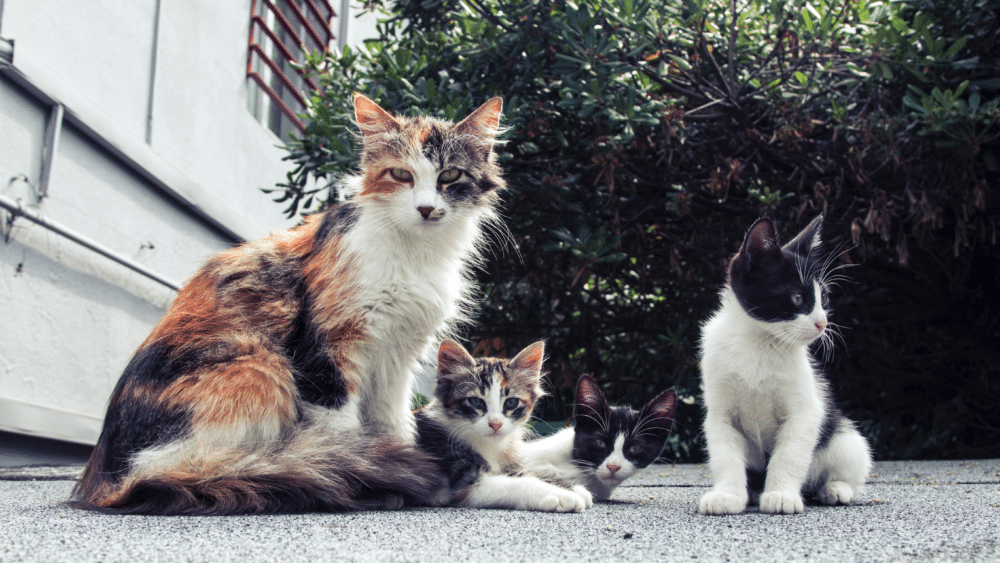
What About Fleas on Kittens?
Many flea control products are only approved for cats over 12 weeks of age, so how do you protect your kitten against fleas? Unfortunately, there are not many commercial flea control products that are safe for kittens because kittens are sensitive to the chemical ingredients which work to kill fleas. Just because you can’t use a traditional flea control product, however, doesn’t mean that you should let a flea infestation go untreated – kittens are especially prone to flea allergy dermatitis and a serious infestation could produce blood loss significant enough to cause anemia.
If your kitten is suffering from a flea infestation, you should follow these steps to get it under control:
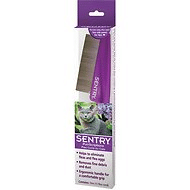
- Use a flea comb to remove as many fleas as you can – you can also use tweezers to pick off individual fleas.
- Run a warm bath and immerse your kitten in it up to his neck, making sure that all of his fur becomes saturated.
- Take your kitten out of the water and place him on a towel then work a small amount of mild dishwashing detergent into his coat, avoiding the face and ears.
- Submerge your kitten in the water again and rinse off all traces of detergent.
- Place your kitten on the towel once more than pick off any remaining fleas using a flea comb or tweezers.
After you’ve thoroughly cleaned your kitten’s coat and removed as many fleas as you could find, you’ll want to wash his bedding and clean the areas where your kitten spends most of his time. It is very important that you prevent re-infestation, so take your task of cleaning very seriously. To protect your kitten against re-infestation, you can use an oral medication like Capstar for kittens over 4 weeks of age. Avoid using any natural remedies on kittens under 8 weeks because they can have a negative reaction.
Small as they may be, fleas can be a serious nuisance and a flea infestation is definitely not something you want to ignore. At the first sign of fleas, take steps to clean your home and to protect your cat. If you need help choosing a flea control product, simply refer to our review of the top ten flea control products provided above.



